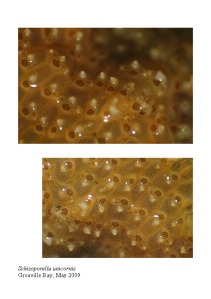
A bryozoan is a minute animal (called a zooid) which encases itself inside a box-like cell which has a single opening through which it feeds using tentacles. Bryozoans live in dense colonies which are attached to hard surfaces, such as rocks and seaweed. They grow in the form of thin encrusting sheets or as delicate branching tufts which are made from dozens of zooids; most colonies only extend for a few centimetres.
The bryozoans were at one time very popular with Victorian naturalists and by the end of the nineteenth century over a hundred species had been recorded from the Channel Islands. At least four species of bryozoan were first discovered in the islands but in recent decades they have been rather overlooked and are not often reported. This is perhaps because bryozoans are small and inconspicuous or perhaps because most species can only be identified with certainty using a microscope.
Bryozoan colonies are easy to find on the middle and lower shore, where they grow on seaweeds (especially the roots of oarweed) and form encrusting patches underneath rocks. Some colonies can be identified using a magnifying glass or, better still, a hand lens but those who are really interested in the animals should collect a small part of the colony and look at it under a dissecting microscope. There are around twenty species of bryozoan which will commonly be found on the Jersey seashore: a selection of these is illustrated here.
Commonly known as “sea mats” or “moss animals” the literal translation of their phylum name Bryozoa
If you have encounter any bryozoans or other unusual animals on the beach then feel free to contact the Société Jersiaise Marine Biological Section and we’ll do our best to identify them for you. societemarine@hotmail.com
Pictures by Paul Chambers – above Schizoporella unicornis (Johnston 1847)
and below Disporella hispida (Fleming 1828)

Tags: Bryozoans, Channel Islands, Zooid
Leave a comment